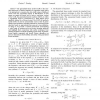856 search results - page 163 / 172 » On Randomness Measures for Social Networks. |
CSUR
1999
13 years 7 months ago
1999
The Web can be naturally modeled as a directed graph, consisting of a set of abstract nodes (the pages) joined by directional edges (the hyperlinks). Hyperlinks encode a considerab...
PERVASIVE
2010
Springer
13 years 9 months ago
2010
Springer
Abstract. Continuous sensing applications (e.g., mobile social networking applications) are appearing on new sensor-enabled mobile phones such as the Apple iPhone, Nokia and Androi...
WWW
2011
ACM
13 years 2 months ago
2011
ACM
The clustering coefficient of a node in a social network is a fundamental measure that quantifies how tightly-knit the community is around the node. Its computation can be reduce...
IJCNN
2007
IEEE
14 years 1 months ago
2007
IEEE
Abstract— The generalised linear model (GLM) is the standard approach in classical statistics for regression tasks where it is appropriate to measure the data misfit using a lik...
CORR
2011
Springer
13 years 2 months ago
2011
Springer
Abstract—Breadth First Search (BFS) is a widely used approach for sampling large unknown Internet topologies. Its main advantage over random walks and other exploration technique...

